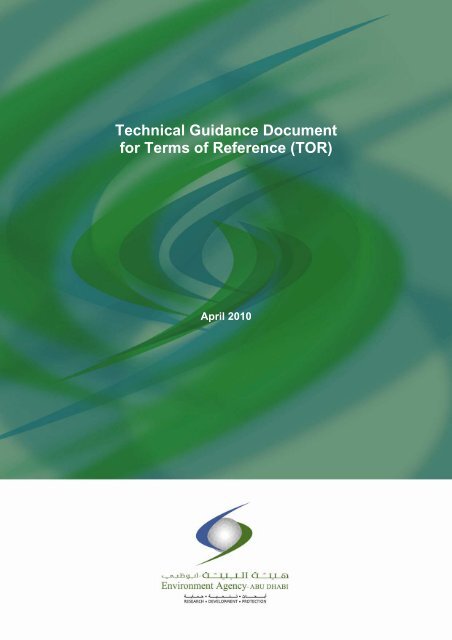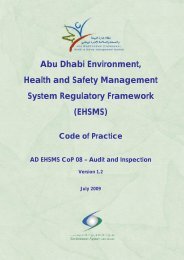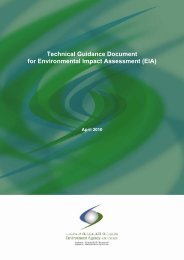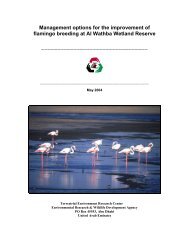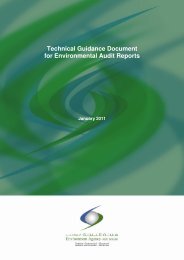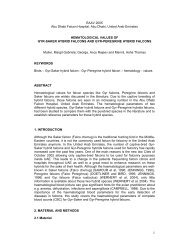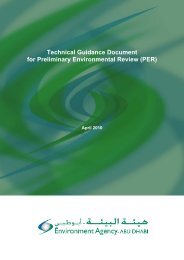Technical Guidance Document for Terms of Reference (TOR)
Technical Guidance Document for Terms of Reference (TOR)
Technical Guidance Document for Terms of Reference (TOR)
Create successful ePaper yourself
Turn your PDF publications into a flip-book with our unique Google optimized e-Paper software.
<strong>Technical</strong> <strong>Guidance</strong> <strong>Document</strong> <strong>for</strong> <strong>Terms</strong> <strong>of</strong> <strong>Reference</strong>environmental baseline condition, probable environmental impacts, and potential approaches tomitigation are <strong>for</strong>eseen, evaluated, and addressed with adequate and straight<strong>for</strong>ward measures andproposed actions. A <strong>TOR</strong> should not make recommendations, decisions, or conclusions about theappropriateness or approval <strong>of</strong> the proposed project.Preparation and Submission <strong>of</strong> a <strong>TOR</strong>The proponent <strong>of</strong> the proposed development or project is responsible <strong>for</strong> preparing and submitting a<strong>TOR</strong>. This document must be prepared by an EAD-approved and -registered consultant operating inAbu Dhabi Emirate. For development and infrastructure projects, a Class A consultant must prepare a<strong>TOR</strong>; <strong>for</strong> an industrial project, a Class A or Class B consultant may prepare a <strong>TOR</strong>. A current list <strong>of</strong>registered consultants can be obtained from EAD.A <strong>TOR</strong> should include, but is not limited to, all <strong>of</strong> the details, content, and requirements outlined inSection II; the sections <strong>of</strong> a <strong>TOR</strong> may be expanded to include other aspects relevant to the proposedproject. The proponent should use the checklist in Table 1 to ensure that all components and criteriaare included and adequately addressed within the <strong>TOR</strong>. A <strong>TOR</strong> should adhere to the frameworkpresented in Table 2 and described in Section II <strong>of</strong> this guidance document.Chapter 1—Executive SummaryTable 1. Checklist <strong>for</strong> Chapter-By-Chapter Review <strong>of</strong> a <strong>TOR</strong>Adequate summary <strong>of</strong> the proposed project <strong>of</strong> a <strong>TOR</strong>Adequate summary <strong>of</strong> the main findings <strong>of</strong> a <strong>TOR</strong> (current baseline environmental conditions andsurveys that will be conducted to fill data gaps, probable environmental impacts and mitigationapproaches to address environmental impacts, and advantages and disadvantages <strong>of</strong> the proposedproject to society and the environment)Chapter 2—IntroductionThe project title, general project description, and project rationaleContact details and in<strong>for</strong>mation about the project proponent and consultantsDescription, including justification and chronology, <strong>of</strong> the development <strong>of</strong> a <strong>TOR</strong>Chapter 3—Legal Framework and StandardsApplicable laws, standards, protocols, and guidelines (e.g., local, regional, Abu Dhabi Emirate,international)Identification <strong>of</strong> source(s) <strong>of</strong> pollutant and contaminant standard limits that will be adopted by a <strong>TOR</strong>(and EIA or SEA that will follow a <strong>TOR</strong>)Chapter 4—Project DescriptionDescription <strong>of</strong> the need <strong>for</strong> the proposed project (economic and social benefits)Maps and descriptions <strong>of</strong> the location and scale <strong>of</strong> the proposed projectDescription <strong>of</strong> the proposed project and the staffing, wastes, chemicals, raw materials, pollutants, anddisturbances associated with all phases (i.e., construction, operation, and decommissioning) <strong>of</strong> theprojectThe project status and scheduleChapter 5—Environment, Impacts, and MitigationDescription <strong>of</strong> the current environmental conditions (baseline conditions) <strong>for</strong> each environmentalcomponent and the data sourcesResults <strong>of</strong> gap analyses to identify missing baseline data <strong>for</strong> each environmental componentDescription <strong>of</strong> additional surveys that will be conducted to fill data gaps regarding the baseline condition<strong>of</strong> each environmental componentMaps showing the spatial distribution <strong>of</strong> the various resources (baseline condition) and survey locationsin the project area and area <strong>of</strong> probable impact (completed <strong>for</strong> each environmental component)Description <strong>of</strong> the potential and probable environmental impacts associated with all phases <strong>of</strong> theproposed project (<strong>for</strong> both the project site and area <strong>of</strong> probable impact) <strong>for</strong> each environmentalcomponent<strong>Document</strong>ation <strong>of</strong> the cause-and-effect relationships between planned project activities andenvironmental impact(s) <strong>for</strong> each environmental component2
<strong>Technical</strong> <strong>Guidance</strong> <strong>Document</strong> <strong>for</strong> <strong>Terms</strong> <strong>of</strong> <strong>Reference</strong>Acknowledgement and description <strong>of</strong> the potential cumulative environmental impacts <strong>for</strong> eachenvironmental componentDescriptions <strong>of</strong> the potential approaches to mitigate the negative impacts <strong>of</strong> the proposed project oneach environmental componentDescriptions <strong>of</strong> the sources (and steps that will be taken to identify sources), the accidentalenvironmental impact risks, and the procedures to minimise these risks and potential impactsChapter 6—Project AlternativesAnnexesGeneralPresentation <strong>of</strong> at least two acceptable alternatives to the current proposed projectDiscussion <strong>of</strong> “no development” and “alternative location” optionsObjective comparison <strong>of</strong> the alternatives and reasons <strong>for</strong> the selection <strong>of</strong> current proposed projectAnnex 1–<strong>Reference</strong>sLogical organisation <strong>of</strong> integrated and easy-to-review components, including annexesClarity (i.e., minimal technical terms, the adequate and appropriate use <strong>of</strong> graphics, text could beunderstood by non-specialists)Include a list <strong>of</strong> abbreviations, definition <strong>of</strong> terms, and full references to sources <strong>of</strong> in<strong>for</strong>mationInclude positive and negative impacts <strong>of</strong> the proposed project in the assessment (<strong>for</strong> objectivity)Include a full suite <strong>of</strong> maps (using standard <strong>for</strong>matting) describing the project, project area, and the area<strong>of</strong> probable impact at different scalesEnsure that adequate in<strong>for</strong>mation is provided, so that EAD can gain a clear understanding <strong>of</strong> theproject, the environmental baseline assessments and surveys, potential environmental impacts, andmitigation options associated with the proposed projectReview <strong>of</strong> a <strong>TOR</strong>EAD <strong>of</strong>ficials will review the submitted <strong>TOR</strong> to verify that all chapters are complete and that the<strong>TOR</strong> meets all <strong>of</strong> the stipulated requirements.After EAD <strong>of</strong>ficials have reviewed and approved a <strong>TOR</strong>, the proponent may proceed with the nextsteps towards conducting an EIA or SEA and the issuance <strong>of</strong> a construction environmental permit.Section II. <strong>TOR</strong> Format and ContentsSection II provides guidelines on the <strong>for</strong>mat and content <strong>of</strong> the <strong>TOR</strong> to be submitted by the proponentto EAD. The <strong>TOR</strong> should have a title page and a Table <strong>of</strong> Contents, with the Table <strong>of</strong> Contentsadhering to the framework and layout outlined in Table 2.Table 2. Standard Table <strong>of</strong> Contents <strong>for</strong> the <strong>TOR</strong>TABLE OF CONTENTSList <strong>of</strong> AbbreviationsDefinitions <strong>of</strong> <strong>Terms</strong>TablesFiguresChapter 1 Executive Summary 1.1 Project Description1.2 Summary <strong>of</strong> FindingsChapter 2 Introduction 2.1 Project Title and Project Proponent2.2 <strong>TOR</strong> Consultants2.3 Project Description and Rationale2.4 Justification and Chronology <strong>for</strong> the Development <strong>of</strong> the <strong>TOR</strong>Chapter 3 Legal Framework andStandardsChapter 4 Project Description 4.1 Statement <strong>of</strong> Need4.2 Project Location and Scale4.3 Project and Activity Description4.4 Project Status and Schedule3
<strong>Technical</strong> <strong>Guidance</strong> <strong>Document</strong> <strong>for</strong> <strong>Terms</strong> <strong>of</strong> <strong>Reference</strong>Chapter 5Chapter 6AnnexesAnnex 1Environment, Impacts,Mitigation, and MonitoringProject Alternatives<strong>Reference</strong>s5.1 Air Quality5.1.1 Description <strong>of</strong> the Environment5.1.2 Environmental Impact Prediction and Evaluation5.1.3 Mitigation Measures* NOTE: Sections 5.2–5.10 should also include the subsectionslisted <strong>for</strong> 5.1, Air Quality5.2 Marine Water5.3 Waste Management5.4 Geology, Seismicity, Soil, and Groundwater5.5 Marine Ecology5.6 Terrestrial Ecology5.7 Noise5.8 Traffic5.9 Socio-economic5.10 Other Environmental Component(s)5.11 Risk AssessmentsThe following text describes the content that should be included in each <strong>of</strong> the chapters and sections<strong>of</strong> the <strong>TOR</strong>.List <strong>of</strong> AbbreviationsThis section should include a list <strong>of</strong> abbreviations and acronyms used in the <strong>TOR</strong>. This list should bepresented in a tabular <strong>for</strong>mat using a <strong>for</strong>mat similar to that on page iii <strong>of</strong> this guidance document.Definitions <strong>of</strong> <strong>Terms</strong>This section should include a list <strong>of</strong> terms used in the <strong>TOR</strong> and their definitions. This in<strong>for</strong>mationshould be presented in a <strong>for</strong>mat similar to that used on page iv <strong>of</strong> this guidance document.List <strong>of</strong> TablesThis section should include a list <strong>of</strong> all the tables presented within the main body <strong>of</strong> the <strong>TOR</strong> andshould indicate table numbers, table titles, and associated page numbers.List <strong>of</strong> FiguresThis section should include a list <strong>of</strong> all the figures presented within the main body <strong>of</strong> the <strong>TOR</strong> andshould indicate figure numbers, figure titles, and associated page numbers.Chapter 1—Executive SummaryChapter 1 in the <strong>TOR</strong> should be a non-technical summary <strong>of</strong> the project description and shouldprovide the main details regarding the environmental baseline data assessments and proposed surveys,environmental impacts and assessments, and mitigation recommendations. This chapter should be inEnglish and Arabic and should include the following sections, which are discussed below:• Project Description• Summary <strong>of</strong> Findings.1.1 Project DescriptionThis section should contain a short description <strong>of</strong> the proposed project. This description shouldprovide enough in<strong>for</strong>mation <strong>for</strong> reviewers to understand the importance and scope <strong>of</strong> the proposedproject.4
<strong>Technical</strong> <strong>Guidance</strong> <strong>Document</strong> <strong>for</strong> <strong>Terms</strong> <strong>of</strong> <strong>Reference</strong>1.2 Summary <strong>of</strong> FindingsThis section should describe the assessments <strong>of</strong> availability <strong>of</strong> environmental baseline data, the likelyenvironmental impacts associated with the proposed project, and the ways in which these impacts willbe resolved through mitigation measures. This section should also address the following in<strong>for</strong>mationand findings:• The main outcomes <strong>of</strong> the environmental baseline data-gathering ef<strong>for</strong>ts and gap analyses• A brief description <strong>of</strong> the environmental baseline surveys and the methodology that should beconducted to fill the data gaps and will be conducted as part <strong>of</strong> the EIA or SEA ef<strong>for</strong>ts• The types and potential magnitudes <strong>of</strong> identified environmental impacts, including the mainand cumulative environmental impacts, when possible• The methods and approaches that will be used to evaluate additional environmental impacts• The mitigation approach(es) that will be taken to address the environmental impacts• The project advantages and disadvantages to the environment and society.General conclusions or recommendations concerning the overall project should not be included in theSummary <strong>of</strong> Findings section.Chapter 2—IntroductionChapter 2 should include in<strong>for</strong>mation, data, and details relevant to the proposed project <strong>of</strong> the <strong>TOR</strong>and be organised according to the following sections, which are discussed below:▪ Project Title and Project Proponent▪ <strong>TOR</strong> Consultants▪ Project Description and Rationale▪ Justification and Chronology <strong>for</strong> the Development <strong>of</strong> the <strong>TOR</strong>.2.1 Project Title and Project ProponentThis section should include the name, address, telephone number, and fax number <strong>of</strong> the proponent’sfirm; the name and designation <strong>of</strong> the contact person who is responsible <strong>for</strong> the project; the project’stitle; and a listing and brief description <strong>of</strong> any other projects that the proponent has conducted, iscurrently conducting, or will conduct on the same site or adjacent to the current proposed project.2.2 <strong>TOR</strong> ConsultantsThis section should include the name, address, telephone number, and fax number <strong>of</strong> the consultant’sfirm; the names <strong>of</strong> the team members from that consultant firm who prepared the <strong>TOR</strong>; and thefield(s) <strong>of</strong> expertise <strong>of</strong> the consultant firm and the individual team members.2.3 Project Description and RationaleThis section should include a description <strong>of</strong> the type and components <strong>of</strong> the proposed project (e.g.,resort with a golf course, a hotel, a water park, an electric generator) and the location and size <strong>of</strong> theproject area. This section should also include the purpose and rationale or justification (e.g., economicand/or social) <strong>for</strong> the proposed project.2.4 Justification and Chronology <strong>for</strong> the Development <strong>of</strong> the <strong>TOR</strong>This section should describe the justification <strong>for</strong> the selection <strong>of</strong> the <strong>TOR</strong> (versus a PreliminaryEnvironmental Review) and the schedule <strong>for</strong> and steps taken to develop the <strong>TOR</strong>. The followingin<strong>for</strong>mation should be included in this section:5
<strong>Technical</strong> <strong>Guidance</strong> <strong>Document</strong> <strong>for</strong> <strong>Terms</strong> <strong>of</strong> <strong>Reference</strong>▪ A list <strong>of</strong> the sequence <strong>of</strong> events and associated dates <strong>for</strong> the selection and preparation <strong>of</strong> the<strong>TOR</strong>▪ A list and description <strong>of</strong> the main outcomes <strong>of</strong> meetings that have already occurred or a list <strong>of</strong>intended meetings with stakeholders, governmental departments, and other groups potentiallyimpacted by development in the area <strong>of</strong> the proposed project.Chapter 3—Legal Framework and StandardsChapter 3 should explain the legislative basis <strong>for</strong> the proposed project outlined in the <strong>TOR</strong> and shouldoutline the following in<strong>for</strong>mation:• All relevant and applicable international laws, standards, and guidelines.• All relevant and applicable regional laws, standards, and guidelines.• All relevant and applicable Emirate and local laws, standards, and guidelines.• International conventions, treaties, and protocols that may be relevant and applicable to theproposed project.• The source document(s) <strong>of</strong> standard pollutant limits. This source document should be themost current, published EAD and federal standards document and address all pollutants andcontaminants that will be produced during the activities and phases <strong>of</strong> the proposedproject<strong>Reference</strong> should be made to the applicable CoP within AD EHSMS RegulatoryFramework, which define the current Standards and Guideline Values <strong>for</strong> air, water, land, andnoise.If Emirate or federal standards are not available, then the best-available source <strong>of</strong> standard limits, witha justification <strong>for</strong> the selection <strong>of</strong> these limits, should be detailed (multiple documents may benecessary).Chapter 4—Project DescriptionChapter 4 should include a general description <strong>of</strong> the proposed project with explanations <strong>for</strong> the need<strong>for</strong> the project and the location, scope, and activities associated with all phases <strong>of</strong> the project. Thischapter should include the following sections, which are discussed below:• Statement <strong>of</strong> Need• Project Location and Scale• Project and Activity Descriptions• Project Status and Schedule.4.1 Statement <strong>of</strong> NeedThis section should include a statement <strong>of</strong> need <strong>for</strong> the proposed project and its compatibility withnational development and environmental strategies. This statement should identify the clients andpotential customers <strong>of</strong> the proposed project, demonstrate why the project should to be located at theproposed site, and demonstrate both economic and social benefits <strong>of</strong> the project.4.2 Project Location and ScaleThis section should describe the exact location and scale <strong>of</strong> the proposed project and should includelocation maps and other relevant visual in<strong>for</strong>mation. The following in<strong>for</strong>mation should be includedand described in this section:• General site description, including the important features and site characteristics unique to theproject site (e.g., natural vegetation areas, soils, geology, bodies <strong>of</strong> water).6
<strong>Technical</strong> <strong>Guidance</strong> <strong>Document</strong> <strong>for</strong> <strong>Terms</strong> <strong>of</strong> <strong>Reference</strong>• The planned layout <strong>for</strong> the proposed project, including all divisions, units and areas <strong>of</strong> activitywithin the project boundaries, addressing all phases (i.e., construction, operation, anddecommissioning, if relevant) <strong>of</strong> the project. When possible, this in<strong>for</strong>mation should bedetailed with text, maps, photographs, and/or tables. If in<strong>for</strong>mation is not available, estimatesfrom similar projects should be used.• Coordinates and geographic boundaries <strong>of</strong> the project area using EAD’s GeographicIn<strong>for</strong>mation Systems—Data Management Standards.• Maps showing the following in<strong>for</strong>mation:– Proposed project site and its immediate surroundings– Proposed project site within the context <strong>of</strong> the regional landscape– Location <strong>of</strong> the proposed project within Abu Dhabi Emirate– Proximity <strong>of</strong> the proposed project to national parks, protected areas, or other areas <strong>of</strong>known sensitivity or environmental importance.4.3 Project and Activity DescriptionsThis section should describe and provide details on the proposed project and the project activitiesassociated with the different phases <strong>of</strong> the project. The in<strong>for</strong>mation presented in this section shouldmatch the expected operations outlined in the project master plan and should include the following:• Descriptions <strong>of</strong> the type, components, and units <strong>of</strong> the proposed project.• Description <strong>of</strong> the processes and activities associated with the construction, operation, anddecommissioning phases (if relevant) <strong>of</strong> the proposed project.• Identification and general descriptions (e.g., locations, amounts) <strong>of</strong> any alterations that will bemade to the project site. Such alterations include, but are not limited to, groundwaterdewatering, dredging, and infilling activities, as well as land excavation and levelling andfilling (cut and fill) activities.• Description <strong>of</strong> the staff that will be at the project sites (e.g., management and administration,maintenance workers, construction workers) during the different phases (i.e., construction,operation, and decommissioning, if relevant) <strong>of</strong> the proposed project. This description shouldindicate the timing <strong>of</strong> their presence, the estimated numbers <strong>of</strong> people involved, and whetherworkers will be housed onsite or nearby.• A list <strong>of</strong> the raw materials and chemicals that are likely to be used during the construction,operation, and decommissioning phases (if relevant) <strong>of</strong> the proposed project and theirassociated purposes and functions.• A description <strong>of</strong> the different wastes (e.g., hazardous, solid, liquid) that will probably begenerated by project activities conducted during the construction, operation, anddecommissioning phases (if relevant) <strong>of</strong> the proposed project.• A list and descriptions <strong>of</strong> all the origins <strong>of</strong> point source emissions and pollution (e.g., gases,liquids, solids, noise) that are likely to be produced by project activities conducted during theconstruction and operation phases <strong>of</strong> the proposed project.4.4 Project Status and ScheduleThis section should describe the current status <strong>of</strong> project implementation, the schedule <strong>of</strong> the proposedproject, and the components and phases therein (if it is a multicomponent or a multiphased project).This section should also include a concise overview <strong>of</strong> the approval procedures and steps <strong>for</strong> theproposed project.7
<strong>Technical</strong> <strong>Guidance</strong> <strong>Document</strong> <strong>for</strong> <strong>Terms</strong> <strong>of</strong> <strong>Reference</strong>Chapter 5—Environment, Impacts, and MitigationChapter 5 should provide a description <strong>of</strong> the environment, probable environmental impacts andpotential mitigation approaches associated with the proposed project. More specifically, this chaptershould describe the current environmental baseline conditions and baseline surveys that will beconducted to fill data gaps, the potential and probable impacts associated with the project, methodsand approaches that will be used to determine other impacts, and plans <strong>for</strong> the mitigation measuresthat will be used to reduce the negative impacts <strong>of</strong> the proposed project on the environment. Thesedescriptions should be created <strong>for</strong> all environmental components that occur within or near the projectarea and should cover all applicable phases <strong>of</strong> project execution (i.e., construction, operation, anddecommissioning).Sections 5.1 through 5.9 in Chapter 5 discuss the environmental components and the correspondingsection number <strong>for</strong> each component as it should appear in the EIA Report. The remaining sectionswithin Chapter 5 (i.e., 5.11, Impacts, Mitigation, and Monitoring Summary; 5.12, Risk Assessment;and 5.13, Environmental Management Framework) are summary sections and address all theenvironmental components together.5.1 to 5.10 Environmental ComponentsTable 2 and Table 3 list each environmental component and its respective section number. If anenvironmental component is not covered in Sections 5.1–5.9, then it should be described and detailedin Section 5.10, Other Environmental Component(s). If an environmental component is not within ornear the project area, and there<strong>for</strong>e will not be impacted by the proposed project, then this should bestated and justified within the corresponding section (5.1–5.9).5.x.1Table 3. Organisation and Corresponding Section Number<strong>for</strong> the Environmental Components That Should Be Addressed in Chapter 5Section NumberEnvironmental Component5.1 Air Quality5.2 Marine Water5.3 Waste Management5.4 Geology, Seismicity, Soil, and Groundwater5.5 Marine Ecology5.6 Terrestrial Ecology5.7 Noise5.8 Traffic5.9 Socio-economic5.10 Other Environmental Component(s)Description <strong>of</strong> the EnvironmentThis section should describe the current status (baseline condition) <strong>of</strong> the environmental component,the results <strong>of</strong> gap analyses that were conducted to determine missing data, and the methods andbaseline surveys that will be used to fill the data gaps and establish the baseline condition <strong>of</strong> theenvironmental component to the level <strong>of</strong> detail required <strong>of</strong> an EIA or SEA. There should be specificemphasis on areas and conditions that may be directly and indirectly affected by any <strong>of</strong> the proposedproject activities conducted during the construction, operation, and decommissioning phases (ifapplicable). Baseline conditions that should be addressed include all existing physical, chemical,biological, and socio-economic conditions relevant to the environmental component. These conditionsshould be evaluated in the project area (i.e., site <strong>of</strong> proposed project) and in the area <strong>of</strong> probableimpact (i.e., the extent <strong>of</strong> the area outside <strong>of</strong> the project area that is likely to be directly or indirectlyimpacted by the proposed project). Maps should be used to describe both the current baselineconditions and the baseline surveys that will be conducted.8
<strong>Technical</strong> <strong>Guidance</strong> <strong>Document</strong> <strong>for</strong> <strong>Terms</strong> <strong>of</strong> <strong>Reference</strong>For the <strong>TOR</strong>, the current condition <strong>of</strong> the environmental component should be described as fully aspossible, based on the outcomes <strong>of</strong> a scoping study. This scoping study should consist <strong>of</strong> datagathering and a gap analysis. Data gathering should involve a desktop review <strong>of</strong> existing data.Suitable data sources include results from previous baseline condition assessments conducted on theproject site and data from studies, literature, or reference documents that describe the environmentalcondition <strong>of</strong> a sufficiently comparable site. For data from such sources, the <strong>TOR</strong> should contain adetailed description <strong>of</strong> the source, the methods used to collect the data (to the level <strong>of</strong> detail containedwithin the source document) and an assessment <strong>of</strong> the validity <strong>of</strong> the data.After existing baseline data have been collected, a gap analysis should be conducted to identify whatdata are missing and what baseline surveys should be per<strong>for</strong>med. This section <strong>of</strong> the <strong>TOR</strong> shoulddescribe the method and results <strong>of</strong> the gap analysis and the baseline surveys that will be conductedand methodology that will be used to fully describe the current condition <strong>of</strong> the environmentalcomponent to the level <strong>of</strong> detail required by the EIA or SEA. The following in<strong>for</strong>mation on thebaseline surveys should be included in this section <strong>of</strong> the <strong>TOR</strong>:▪ Parameters to be assessed▪ Survey location and boundaries (with maps)▪ The number <strong>of</strong> samples collected or sampling sites (with justification and methods used todetermine number <strong>of</strong> sampling sites and sample site locations)▪ Proposed location <strong>of</strong> sample collection sites (with maps and justification <strong>of</strong> selection)▪ Duration and frequency <strong>of</strong> the survey (addressing daily, seasonal, and annual trends)▪ Survey methodology and the basis <strong>for</strong> selecting the methodology (should be based oninternational standards)▪ Quality assurance/quality control methods to be adopted during sample collection▪ Methods that will be used <strong>for</strong> validating the data▪ Justification that the selected survey system will accurately and comprehensively representthe condition <strong>of</strong> the environmental component.When designing baseline surveys, the proponent and consultant should refer to the EAD-issuedpamphlet titled General Guidelines <strong>for</strong> Submission <strong>of</strong> Baseline Environmental Data, along with the<strong>Technical</strong> guidelines within the EHSMS Regulatory Framework, and should adhere to the guidanceregarding data collection, <strong>for</strong>matting, and reporting methods.5.x.2 Environmental Impact Prediction and EvaluationThis section should address the potential and probable impacts <strong>of</strong> the proposed project onenvironmental components, to the level <strong>of</strong> detail allowed by the description <strong>of</strong> the environmentalbaseline condition outlined in Section 5.x.1. This section should also address the direct and indirectimpacts <strong>of</strong> the proposed project in the project area and area <strong>of</strong> probable impact and describe the waysin which impacts will be assessed and determined <strong>for</strong> environmental components and attributes thatare lacking baseline data. The following in<strong>for</strong>mation should be included and described in this section:▪ All <strong>of</strong> the potential and probable impacts <strong>of</strong> the proposed project and their respective sources,including a description <strong>of</strong> the cause-and-effect relationships between project activities andenvironmental impacts.▪ If no impacts are anticipated, then this should be stated, along with a supporting justification<strong>for</strong> the conclusion (e.g., No impacts are anticipated to marine ecology because the facility willbe located 50-km inland).▪ Note any relevant and current standards that would apply to the impacts or sources <strong>of</strong> theimpacts (outlined in standards documents presented in Chapter 3, Legal Framework andStandards)9
<strong>Technical</strong> <strong>Guidance</strong> <strong>Document</strong> <strong>for</strong> <strong>Terms</strong> <strong>of</strong> <strong>Reference</strong>▪ Identification <strong>of</strong> potential cumulative impacts. Cumulative impacts are impacts that resultfrom the incremental impact <strong>of</strong> an action added to other actions. There<strong>for</strong>e, the potentialimpacts <strong>of</strong> the proposed project should be considered in the context <strong>of</strong> participating in acumulative impact from past, current, and <strong>for</strong>eseeable future industrial and non-industrialactivities on the project site and within and near the area <strong>of</strong> probable impact.▪ The methods, models, and approaches that will be used to determine environmental impactsin the EIA or SEA ef<strong>for</strong>ts that will follow this <strong>TOR</strong>.5.x.3 Mitigation MeasuresThis section should describe the mitigation measures and approaches that could be used to address thenegative impacts <strong>of</strong> the proposed project on the environmental component. All impacts presented inSection 5.x.2 should be addressed and should be described to the level <strong>of</strong> detail allowed by thedescriptions <strong>of</strong> the impacts in Section 5.x.2.5.11 Risk AssessmentsThis section should describe the steps that will be taken to identify the risks associated with impacts tothe environment that could occur as a result <strong>of</strong> mishaps or failures during the construction, operation,and decommissioning phases (if relevant) <strong>of</strong> the proposed project. Examples <strong>of</strong> such occurrences arefailure <strong>of</strong> material or equipment, procedures not being followed, un<strong>for</strong>eseen non-routine processupsets, and process equipment or processes not per<strong>for</strong>ming according to design parameters. Typicalexamples <strong>of</strong> impacts through mishaps include, but are not limited to, spills, leaks, fires, explosions,and process blow-downs.If this <strong>TOR</strong> is preceding an EIA, then this section should also specifically address the steps that willbe taken and the in<strong>for</strong>mation that is necessary to develop a comprehensive Hazard and EffectsRegister and Control <strong>of</strong> Major Accident Hazards (COMAH) reports, if necessary. If accidentalenvironmental impact risks associated with the proposed project are already known, then this sectionshould contain more detailed in<strong>for</strong>mation regarding: (1) environmental hazards that could beencountered during a phase, activity, or process associated with the proposed project; (2) the level <strong>of</strong>risk associated with each identified hazard; and (3) the control and recovery measures that will beimplemented to minimise the risk <strong>of</strong> the occurrence and impact <strong>of</strong> each hazard. This in<strong>for</strong>mationshould be presented in enough detail to demonstrate that the proposed project has acknowledged thepotential risks associated with the hazards to the environment and that facilities, activities, andprocesses <strong>of</strong> the project will be operated with measures and protocols to avoid or contain direct andindirect risks associated with the identified hazards.Chapter 6—Project AlternativesChapter 6 should list and describe alternative approaches to components <strong>of</strong> the proposed project,particularly aspects <strong>of</strong> the project that are likely to have the largest impact on the environment, andprovide examples <strong>of</strong> less impacting alternatives. The alternatives do not need to be described in detailin the <strong>TOR</strong>, but they will need to be fully explored in the EIA. Aspects that should be consideredinclude the processes, technologies, size, implementation, impacts <strong>of</strong> the alternative approach on theenvironment, and cost. “No-development” and “alternative location” options should be fully discussedin the <strong>TOR</strong>, along with rationale <strong>for</strong> choosing to proceed with the project at the specified location.AnnexesAnnexes should include all in<strong>for</strong>mation not immediately relevant to the main text <strong>of</strong> the <strong>TOR</strong>. At aminimum, the <strong>TOR</strong> should include an annex that lists references. Additional annexes should be addedas needed.10


